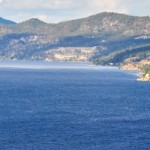A major water crisis is coming to British Columbia unless we change how this vital resource is managed, says a new report. And we’re going to feel it in the Okanagan first.
In a report released last week, the Pacific Fisheries Resource Conservation Council points out that B.C.’s population is growing, our rates of water consumption are among the highest in the world and that climate change is leading to hotter weather and smaller snowpacks, further reducing the supply of freshwater.
“Water scarcity undermines the viability of our communities and the health of our streams,” it says. The Pacific Fisheries Resource Conservation Council is an independent advisory body set up by the federal government.
Valley residents have already had a hint of what is to come, according to the report. For example, in 2003, the town of Summerland had to release water from its storage facilities into Trout Creek to save fish. As a result, less water was available for farmers.
The report also says that areas of the province which with the fastest growing populations – like the Okanagan- are also the ones reaching their limits on water use the fastest.
“First and foremost, I think the report really emphasizes the need to start looking at water as an increasingly scarce resource and it also highlights the fact that we have to manage our water resources more efficiently so we can better balance the needs of people, industry and agriculture on one hand and the needs of rivers and fish on the other,” said Mark Angelo, PFRCC chairman and head of the Fish, Wildlife and Recreation Department at BCIT.
The particularly hot and dry weather this summer has only made things worse. “There are a lot of streams running at really low levels,” said Angelo. “In many cases that’s exacerbated by excessive water withdrawals.”
Angelo noted that the provincial government recently curtailed water extraction from the Nicola River because low water flows were threatening Kokanee populations. The lower water volumes makes it harder for fish to swim upstream, increases water temperature and reduces the amount of habitat.
B.C.’s excessive water consumption is made worse by our growing population.
“We tend to use well over 300 litres per person, per day, so I think there’s lots of room to try and use water more efficiently,” said Angelo.
Part of the solution is providing financial incentives for people to conserve water, according to Angelo, who would like to see more water meters installed, like those in the City of Kelowna, so people pay for the water they actually use.
He also suggested instituting different pricing tiers so “excessive” users pay more for the extra water they consume.
Angelo also said the province’s Water Act, which dates back to 1909, is in dire need of updating. “It has to be revised to deal with the present day realities.”
The act currently only deals with how water extraction licenses are allocated, he said. “It’s virtually silent on things like the need to maintain healthy aquatic ecosystems and it’s virtually silent on the need to protect fish.”
Many license holders do not use all the water they are entitled to, but if they did, many of B.C.’s rivers and streams would be drained.
“On the Nicola [river], if all of those licenses were used to their maximum potential, you would have a stream that would be close to dry,” said Angelo.
The coming water woes will be felt throughout the province but are likely to hit the the valley first, said Angelo.
“The Okanagan is one of the great places in the entire world to live but you’re seeing some dramatic increases in population. Your precipitation levels, though, are less than other parts of the province,”he said, adding that climate change is exacerbating the challenges. “You are going to see pressures and stresses on water supplies probably sooner – you’re already seeing them- and if anything those pressures or stresses are going to be greater in the Okanagan.”

